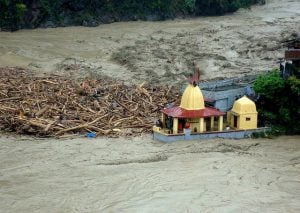“We wanted a simple pilgrimage. What we got instead was a nerve-wracking adventure,” says Savita Khatri, 56, a devotee who had to be airlifted from the north Indian town of Joshimath after torrential rain forced her to abort the Char Dham Yatra. The annual Hindu pilgrimage sees millions trek through treacherous terrain to the holy sites of Kedarnath, Badrinath, Gangotri, Yamunotri, and Hemkund Sahib in the scenic Himalayan state of Uttarakhand.
This year’s rain yet again left thousands of devotees stranded across Uttarakhand, ironically known as `dev bhumi’ or land of the Gods due to its once pristine environment. Massive aerial and ground rescue operations by the Army and the National Disaster Response Force revived memories of floods and landslides that had blighted the state two years ago. Indian Air Force choppers operated in inclement weather to evacuate devotees all along the pilgrimage routes even as Army personnel began the arduous task of reconstructing bridges swept away by flash floods.
Read also: Uttarakhand still vulnerable as millions of pilgrims descend
As the state government – under Chief Minister Harish Rawat – scrambled to save the pilgrims, land routes to the popular Kedarnath shrine in Rudraprayag district and Hemkund Sahib were shut down due to landslips. An Uttarakhand Disaster Mitigation and Management Centre press release stated that over 9,000 pilgrims, including 5,000 on the Hemkund Sahib route and 3,000 at Badrinath, were stranded for almost two days with all communication lines snapped.
The six-month long pilgrimage, from April to October, remains obstructed even a week after rains as restoration work on roads and bridges leading up to the holy shrines is still underway. Some devotees who had to abandon their pilgrimage told thethirdpole.net that they were ferried across the river by Indo-Tibetan Border Police personnel on rope pulleys after three pedestrian bridges were washed away by flood at Hemkund Sahib.
“It was an experience we’d not bargained for,” says Bina Srivastava, a school principal in New Delhi who had embarked on the pilgrimage last week. “The Yatra takes place every year, so do monsoons. Why can’t the government be better prepared to handle the event considering tourism drives the state’s economy?”
Since 2005, heavy monsoon floods have crippled Uttarakhand almost each year, disrupting the important Yatra or worse, forcing the state government to suspend it, jeopardizing millions generated in tourism revenue. Experts say there is no quick fix to the problem either as tampering with the state’s fragile ecology has thrown its environmental balance off kilter.
Forest cover in the Himalayas
The India State of Forest Report 2013 reveals that Uttaranchal’s skewed development pattern is ruining the state’s ecology as well as its economy. The forest cover in this state in the central Himalayas had dwindled astoundingly, states the report. Between 2001 and 2013, the state lost about 500 sq. km of forest cover, most of it in Uttarkashi and Rudraprayag districts, the fount of the monsoon-induced flash floods in recent years.
“Forests are vital to check the crushing flow of monsoon rains,” conservationist Vikram Soni told thethirdpole.net. “The tree density in the forests of Uttarakhand, which has dipped significantly over the years, is unable to do this which has created this alarming situation. And it is only going to get worse.”
As the forest quality goes down, explains Soni, its ability to retain water diminishes resulting in higher erosion. “In such a scenario, it is vital that roads don’t block natural waterways; else, the intensity of flash floods increases manifold. Unfortunately, in Uttarakhand, most of the roads are being built on old fault lines despite warnings from geologists.”
According to Rajendra Singh – known as India’s water man – the ambitious development of a vast network of roads in the state’s ecologically sensitive interiors has caused irreversible damage to the region. “It is nobody’s case that all development be halted. But such construction should respect the geo-cultural diversity of the mountainous region. The unregulated development of hotels and resorts and tourism infrastructure is singularly responsible for the state’s repeated calamities.”
The state has also consistently ignored exhortations from the National Disaster Management Authority, which had warned against flouting environmental rules while building roads. A large number of hydel projects are popping up in the state further worsening the situation. Hydel projects disturb the natural river flow, creating a domino effect. It leads to increased intensity of flash floods and rains triggering frequent landslides.
Harish Rawat – who took over the reins of administration last February – had pledged to ensure smooth Yatras each year. He had also promised to begin in right earnest reconstruction work on infrastructure damaged by previous landslides and floods. Experts remain sceptical of that claim. Nor has the state announced any proactive steps to counter future unregulated growth, they add.
A 2014 study by eminent ecologist Ravi Chopra, called Uttarakhand: Development and Ecological Sustainability, points out that for a disaster-prone state like Uttarakhand, a constant state of disaster preparedness at every level needs to be urgently integrated into the development plan. “Uttarakhand needs to strategically implement the Disaster Management Act, 2005… Technology-based approaches like early warning systems should be supplemented by community-based disaster preparedness,” states the report.
Among the study’s other suggestions are guidelines for building safer, greener roads in the region as well as effective disaster management systems and procedures established at the community, district and state level to avoid repeated loss from natural calamities. The National Mission for Sustaining the Himalayan Ecosystem has detailed guidelines in this regard, but few policymakers in any Himalayan state are even aware of them.
As Rajendra Singh puts it, “State governments continue to neglect Uttarakhand’s predominantly mountain character as well as a people-centric green development approach. What is being followed blindly instead is the ruinous, commerce-driven model of development endorsed by the rest of urban India. This is a sure-shot recipe for disaster.”


